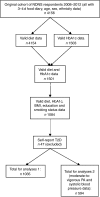An investigation into the relationship between plain water intake and glycated Hb (HbA1c): a sex-stratified, cross-sectional analysis of the UK National Diet and Nutrition Survey (2008-2012)
- PMID: 27831459
- PMCID: PMC5197923
- DOI: 10.1017/S0007114516003688
An investigation into the relationship between plain water intake and glycated Hb (HbA1c): a sex-stratified, cross-sectional analysis of the UK National Diet and Nutrition Survey (2008-2012)
Abstract
The aim of this study was to analyse the association between plain water intake and glycated Hb (HbA1c) in the National Diet and Nutrition Survey (2008-2012) rolling survey. These data included diet (4-d diaries) and HbA1c (fasted blood sample) measures of 456 men and 579 women aged 44 (sd 18) years with full information on covariates of interest (age, ethnicity, BMI, smoking status, education, other beverage intake, energy intake and fibre). Data were analysed using sex-stratified linear and logistic regressions modelling the associations of cups per d (240 ml) of plain water with HbA1c, and odds of HbA1c≥5·5 %, respectively. Substitution analyses modelled the replacement of sugar-sweetened beverages, fruit juice and artificially sweetened beverages with plain water. After adjustment, 1 cup/d of plain water was associated with a -0·04 % lower HbA1c (95 % CI -0·07, -0·02) in men. In logistic regression, men had a 22 % (95 % CI 10, 32 %) reduced odds of HbA1c≥5·5 %/cup per d of plain water. There was no evidence of an association with either HbA1c or odds of HbA1c≥5·5 % in women. None of the substitution models was associated with a change in odds of HbA1c≥5·5 %. Plain water intake was associated with lower HbA1c in men but not in women. Substituting water for specific beverages was not associated with a reduced odds of HbA1c≥5·5 %, suggesting that the addition of water is the more pertinent factor. Future trials should test whether the relationships between water intake and HbA1c is causal as this could be a cost-effective and simple health intervention.
Keywords: AVP arginine vasopressin; EER estimated energy requirements; EI energy intake; HbA1c glycated Hb; IQR interquartile range; NDNS National Diet and Nutrition Survey; PA physical activity; SSB sugar-sweetened beverages; T2D type 2 diabetes; Fluid balance; Glycated Hb; Hydration; Metabolism; Type 2 diabetes.
Figures



 , Men <5·5 %
(n 221);
, Men <5·5 %
(n 221);  , men ≥5·5 % (n 235);
, men ≥5·5 % (n 235);
 , women <5·5 % (n
295);
, women <5·5 % (n
295);  , women ≥5·5 % (n 284).
Excl., excluding.
, women ≥5·5 % (n 284).
Excl., excluding.

Similar articles
-
Beverage Consumption During Pregnancy and Birth Weight: A Systematic Review [Internet].Alexandria (VA): USDA Nutrition Evidence Systematic Review; 2020 Jul. Alexandria (VA): USDA Nutrition Evidence Systematic Review; 2020 Jul. PMID: 35349234 Free Books & Documents. Review.
-
Cross-sectional association between sugar-sweetened beverage intake and cardiometabolic biomarkers in US women.Br J Nutr. 2018 Mar;119(5):570-580. doi: 10.1017/S0007114517003841. Br J Nutr. 2018. PMID: 29508692 Free PMC article.
-
Beverage intake among preschool children and its effect on weight status.Pediatrics. 2006 Oct;118(4):e1010-8. doi: 10.1542/peds.2005-2348. Pediatrics. 2006. PMID: 17015497
-
Plain-water intake and risk of type 2 diabetes in young and middle-aged women.Am J Clin Nutr. 2012 Jun;95(6):1454-60. doi: 10.3945/ajcn.111.032698. Epub 2012 May 2. Am J Clin Nutr. 2012. PMID: 22552035 Free PMC article.
-
Beverage Consumption and Growth, Size, Body Composition, and Risk of Overweight and Obesity: A Systematic Review [Internet].Alexandria (VA): USDA Nutrition Evidence Systematic Review; 2020 Jul. Alexandria (VA): USDA Nutrition Evidence Systematic Review; 2020 Jul. PMID: 35349233 Free Books & Documents. Review.
Cited by
-
A Narrative Review on Strategies for the Reversion of Prediabetes to Normoglycemia: Food Pyramid, Physical Activity, and Self-Monitoring Innovative Glucose Devices.Nutrients. 2023 Nov 28;15(23):4943. doi: 10.3390/nu15234943. Nutrients. 2023. PMID: 38068801 Free PMC article. Review.
-
THIRSTY FOR FRUCTOSE: Arginine Vasopressin, Fructose, and the Pathogenesis of Metabolic and Renal Disease.Front Cardiovasc Med. 2022 May 17;9:883365. doi: 10.3389/fcvm.2022.883365. eCollection 2022. Front Cardiovasc Med. 2022. PMID: 35656391 Free PMC article. Review.
-
Associations between urinary hydration markers and metabolic dysfunction: a cross-sectional analysis of NHANES data, 2008-2010.Eur J Nutr. 2021 Dec;60(8):4229-4241. doi: 10.1007/s00394-021-02575-3. Epub 2021 May 18. Eur J Nutr. 2021. PMID: 34003332 Free PMC article.
-
The association between water intake and future cardiometabolic disease outcomes in the Malmö Diet and Cancer cardiovascular cohort.PLoS One. 2024 Jan 19;19(1):e0296778. doi: 10.1371/journal.pone.0296778. eCollection 2024. PLoS One. 2024. PMID: 38241317 Free PMC article.
-
Prevention and Therapy of Type 2 Diabetes-What Is the Potential of Daily Water Intake and Its Mineral Nutrients?Nutrients. 2017 Aug 22;9(8):914. doi: 10.3390/nu9080914. Nutrients. 2017. PMID: 28829398 Free PMC article. Review.
References
-
- European Food Safety Authority (2010) Scientific opinion on dietary reference values for water. EFSA J 8, 1459.
-
- Kant AK, Graubard BI & Atchison EA (2009) Intakes of plain water, moisture in foods and beverages, and total water in the adult US population – nutritional, meal pattern, and body weight correlates: National Health and Nutrition Examination Surveys 1999–2006. Am J Clin Nutr 90, 655–663. - PMC - PubMed
-
- Negoianu D & Goldfarb S (2008) Just add water. J Am Soc Nephrol 19, 1041–1043. - PubMed
-
- Taveau C, Chollet C, Waeckel L, et al. (2015) Vasopressin and hydration play a major role in the development of glucose intolerance and hepatic steatosis in obese rats. Diabetologia 58, 1081–1090. - PubMed
LinkOut - more resources
Full Text Sources
Other Literature Sources
Miscellaneous

